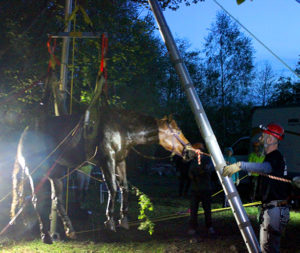
As we were wrapping up this spring’s Fundamentals Training, we received a call about a horse in a creek in Everett. Part of the training involved the technical rescue team giving a demo on the bipod/tripod and various rope systems, so many of the technical responder were on site at the training, dressed, and ready to go, so we headed out to Everett from the training in Buckley, about 90 minutes away. We also sent out a call for other members up to date on their credentials because we suspected we’d need all the hands we could get.
We arrived on scene with an hour of daylight to spare and were directed to the creek, which ran through a cow pasture that was thankfully accessible to the equipment van. The horse, a Thoroughbred named Honey, lay in a slackwater creek just to the side of a bridge, forelegs extended out from a number of attempts at self-rescue. She shivered from the stress.
The location’s geography would make this a difficult rescue. The creek cut deep into the silt of the ground and the soft muck on the bottom of the creek made the situation dangerous.
We had a quick discussion about the different options and finally settled on placing one foot of the bipod on the bridge and one on the rescue side of the bank. We’d try to slip the supporting straps of the Becker sling under Honey and then lower the spreader bar to attach to the straps. After this we’d lift her vertically, pivot the bipod to solid ground and lower her.
One of the big dangers we needed to work around was the deep muck at the bottom of the creek and the muddy water. We couldn’t have a rescuer in the water with her. The water barely moved but the unexpected flailing of the horse could suck a responder under the animal and into the mud. JC, one our best horse handlers, would be attendant to the horse, meaning he’d work closest to her and try to keep her as calm as possible. He stood on the steep bank, talking to Honey as we prepped. To keep JC safe, he put on a climbing harness and we attached a safety rope and had someone manage the rope so he wouldn’t fall in.
We also had the good fortune to have a vet, Dr. Penny Lloyd of Cedarbrook Veterinary Care, on site with a sedative in case Honey needed a bit of help to stay calm and advice should we need it.
JC and a few others worked on getting the support straps under Honey with a strope guide, which is a long flat piece of metal with an opening at the end to slip straps through. The guide slides under the horse, the straps are threaded through the opening, and then the guide is pulled back through with the strap following like thread on a needle. Honey’s continued attempts to self-rescue made this difficult.
While this was going on, the rest of the team built the bipod and set up the rope systems that would manage the bipod angles, raise the horse, and stabilize the whole system.
We were ready to go just as dark descended.
Often times when horses are stuck in mud or bogs, we have to be very careful of the suction that will fight the raise and damage the horse’s legs. Legs are meant to bear weight, not be pulled on. The muck was very water-heavy so we didn’t need to be as concerned with this, though we were cognizant of it as we gave the order to pull.
Honey cleared out of the water fairly easily, and seemed calm. However, once in the air, she thrashed and we were very glad of the careful rigging which kept her and everyone safe.
We pivoted the bipod to swing Honey onto the rescue side of the creek. Just before she touched down, she panicked and thrashed some more. As soon as she calmed a bit, Dr. Penny slipped in and gave her a sedative, which helped nearly immediately.
We continued to lower her. The sedative kept her from noticing the ground right away, but as soon as she did, she stood and was able to bear weight on all four legs.
We unhooked her from the sling and she was led away to be examined more thoroughly by Dr. Penny. We took a deep breath, gathered our stuff, and headed home.
We’ve heard Honey has a few scrapes and scratches but is doing well and being taken care of.
A big thanks to Honey’s owner, the property owners, neighbors, Dr. Penny, everyone else who was on site to lend a hand, as well as the Snohomish County Sheriff’s Office for giving us the gift of their trust. We’re very appreciative of the support they gave us.
If you appreciate what we do, we can always use donations for gas money or to help replace our more specialized and expensive equipment as it gets stressed and taken out of service. We’re an all-volunteer 501(c)(3) nonprofit organization and all donations are tax deductible.
http://washingtonsart.org/donate
Thanks for your support everyone!

 Baby Girl Pig Raise
Baby Girl Pig Raise